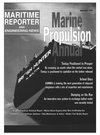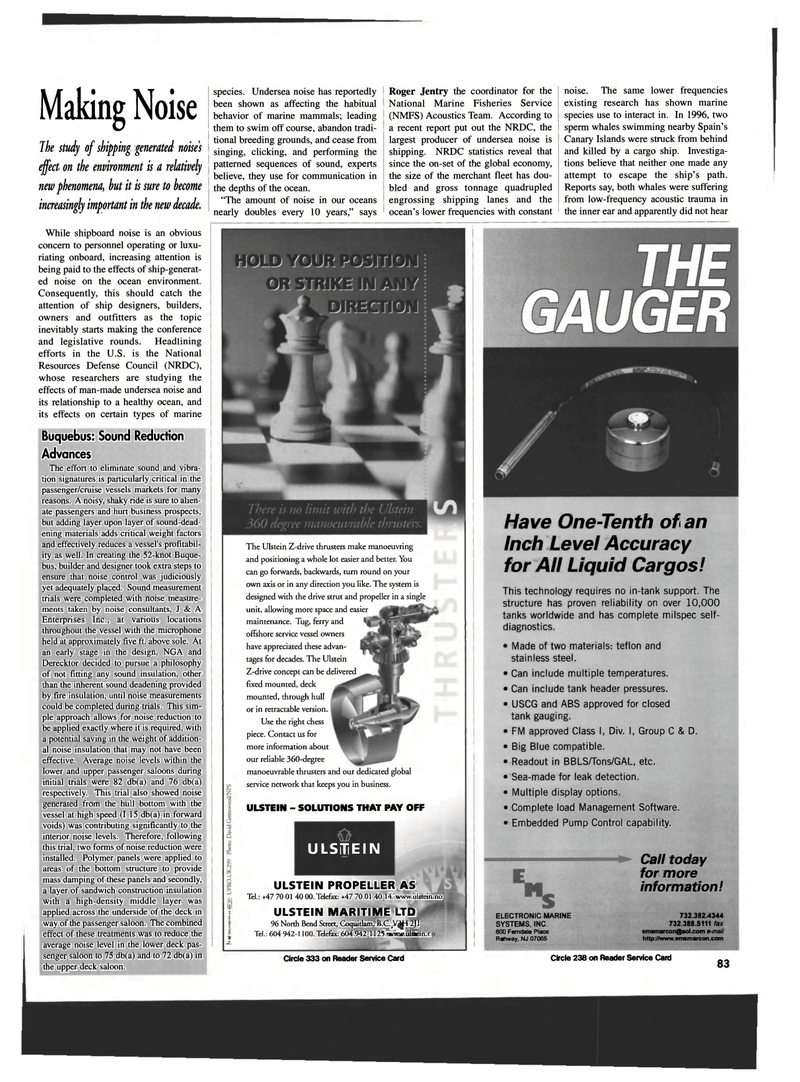
Page 85: of Maritime Reporter Magazine (September 1999)
Read this page in Pdf, Flash or Html5 edition of September 1999 Maritime Reporter Magazine
Making Noise
The study of shipping generated noises effect on the environment is a relatively new phenomena, but it is sure to become increasingly important in the new decade.
While shipboard noise is an obvious concern to personnel operating or luxu- riating onboard, increasing attention is being paid to the effects of ship-generat- ed noise on the ocean environment.
Consequently, this should catch the attention of ship designers, builders, owners and outfitters as the topic inevitably starts making the conference and legislative rounds. Headlining efforts in the U.S. is the National
Resources Defense Council (NRDC), whose researchers are studying the effects of man-made undersea noise and its relationship to a healthy ocean, and its effects on certain types of marine
Buquebus: Sound Reduction
Advances
The effort to eliminate sound and vibra- tion signatures is particularly critical in the passenger/cruise vessels markets for many reasons. A noisy, shaky ride is sure to alien- ate passengers and hurt business prospects, but adding layer upon layer of sound-dead- ening materials adds critical weight factors and effectively reduces a vessel's profitabil- ity as well. In creating the 52-knot Buque- bus, builder and designer took extra steps to ensure that noise control was judiciously yet adequately placed. Sound measurement trials were completed with noise measure- ments taken by noise consultants, J & A
Enterprises Inc., at various locations throughout the vessel with the microphone held at approximately five ft. above sole. At an early stage in the design, NGA and
Derecktor decided to pursue a philosophy of not fitting any sound insulation, other than the inherent sound deadening provided by fire insulation, until noise measurements could be completed during trials. This sim- ple approach allows for noise reduction to be applied exactly where it is required, with a potential saving in the weight of addition- al noise insulation that may not have been effective. Average noise levels within the lower and upper passenger saloons during initial trials were 82 db(a) and 76 db(a) respectively. This trial also showed noise generated from the hull bottom with the vessel at high speed (I 15 db(a) in forward voids) was contributing significantly to the interior noise levels. Therefore, following this trial, two forms of noise reduction were installed. Polymer panels were applied to areas of the bottom structure to provide mass damping of these panels and secondly, a layer of sandwich construction insulation with a high-density middle layer was applied across the underside of the deck in way of the passenger saloon. The combined effect of these treatments was to reduce the average noise level in the lower deck pas- senger saloon to 75 db(a) and to 72 db(a) in the upper deck saloon. species. Undersea noise has reportedly been shown as affecting the habitual behavior of marine mammals; leading them to swim off course, abandon tradi- tional breeding grounds, and cease from singing, clicking, and performing the patterned sequences of sound, experts believe, they use for communication in the depths of the ocean. "The amount of noise in our oceans nearly doubles every 10 years," says
Roger Jentry the coordinator for the
National Marine Fisheries Service (NMFS) Acoustics Team. According to a recent report put out the NRDC, the largest producer of undersea noise is shipping. NRDC statistics reveal that since the on-set of the global economy, the size of the merchant fleet has dou- bled and gross tonnage quadrupled engrossing shipping lanes and the ocean's lower frequencies with constant noise. The same lower frequencies existing research has shown marine species use to interact in. In 1996, two sperm whales swimming nearby Spain's
Canary Islands were struck from behind and killed by a cargo ship. Investiga- tions believe that neither one made any attempt to escape the ship's path.
Reports say, both whales were suffering from low-frequency acoustic trauma in the inner ear and apparently did not hear
The Ulstein Z-drive thrusters make manoeuvring and positioning a whole lot easier and better. You can go forwards, backwards, turn round on your own axis or in any direction you like. The system is designed with the drive strut and propeller in a single unit, allowing more space and easier maintenance. Tug, ferry and offshore service vessel owners have appreciated these advan- tages for decades. The Ulstein
Z-drive concept can be delivered fixed mounted, deck mounted, through hull or in retractable version.
Use the right chess piece. Contact us for more information about our reliable 360-degree manoeuvrable thrusters and our dedicated global service network that keeps you in business.
ULSTEIN - SOLUTIONS THAT PAY OFF
ULSTEIN
ULSTEIN PROPELLER AS
Tel.: +47 70 01 40 00. Telefex: +47 70 01 40 14. www.uistein.no
ULSTEIN MARITIME LTD 96 North Bend Street, Coquitlam, B.CjV^-12J,1
Tel.: 604 942-1 100. Telefax: 604 942-1125. www.ulstein.r
Cirde 333 on Reader Service Card
Have One-Tenth of an
Inch Level Accuracy for All Liquid Cargos!
This technology requires no in-tank support. The structure has proven reliability on over 10,000 tanks worldwide and has complete milspec self- diagnostics. • Made of two materials: teflon and stainless steel. • Can include multiple temperatures. • Can include tank header pressures. • USCG and ABS approved for closed tank gauging. • FM approved Class I, Div. I, Group C & D. • Big Blue compatible. • Readout in BBLS/Tons/GAL, etc. • Sea-made for leak detection. • Multiple display options. • Complete load Management Software. • Embedded Pump Control capability.
ELECTRONIC MARINE
SYSTEMS, INC. 800 Ferndale Place
Rahway, NJ 07065
Call today for more information! 732.382.4344 732.388.5111 fax [email protected]) e-mail http://www.emsmarcon.com
Circle 238 on Reader Service Card 83

 84
84

 86
86
